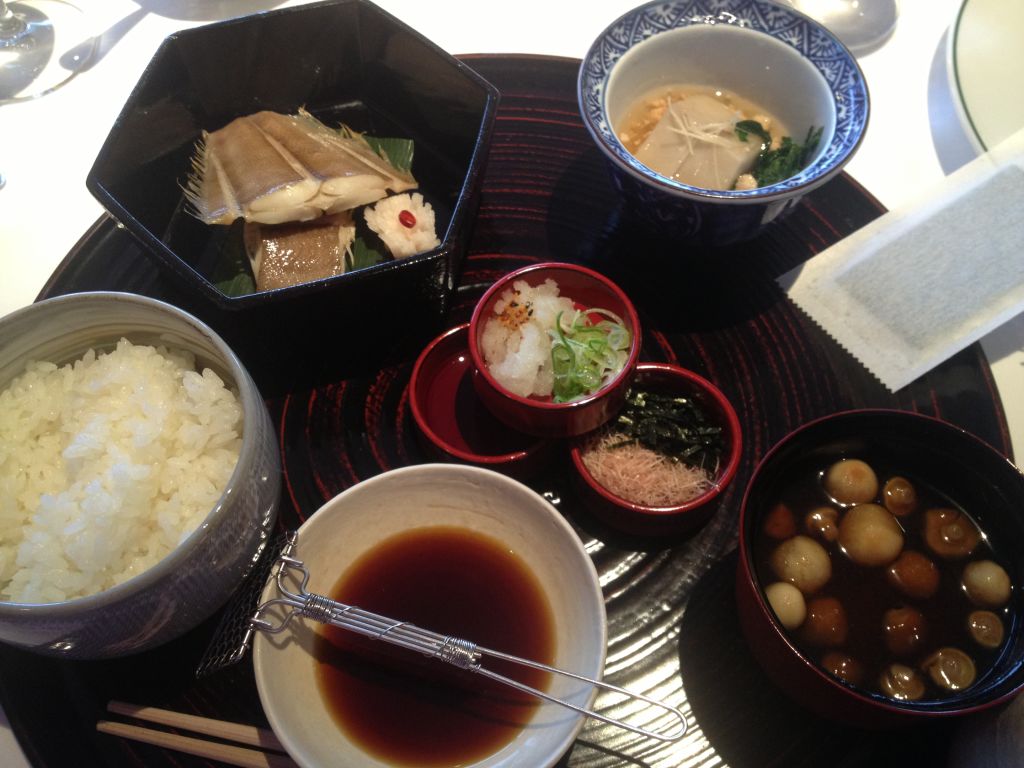
Breakfast of (Japanese) Champions

TOKYO – Screw Wheaties. What passes for breakfast in the U.S. – a bowl of cereal, two scrambled eggs, maybe a strip of bacon – looks positively caveman compared to what the Japanese consider a proper way to start the day. Channeling a bit of Bill Murray and Scarlett Johansson at the Park Hyatt here one morning last week, the Japanese Breakfast couldn’t be more understated. It’s listed on the menu pretty simply:
Selection of Juices (Orange, Apple, Grapefruit, Cranberry, Vegetable or Tomato)
Appetiser, Grilled Fish, Simmered Vegetables, Egg, Tofu
Miso Soup, Rice, Pickled Vegetables
Fresh Fruits
But the rundown bares little resemblance to what is actually served.
It is both impressive – from a purely Japanese aesthetic – and yet devastatingly simple. In the middle of the enormous tray, a trio of small, circular containers, filled with condiments: grated daikon radish, an assertive seven spice (shichimi), whispy, delicate bonito flakes (itogaki, or dried tuna), seaweed strips (hari-nori), finely-sliced leeks, plus ground radish and scallions. All of these ingredients are meant to be combined with a bit of soy, serving as an umami bomb of a dipping sauce for the lightly grilled flounder or the delicate, soft tofu.
To the left of the main tray, a large, circular bowl is filled with giant lobes of soft, silken tofu. Unlike the packaged varieties we typically see in the U.S., the tofu here is handmade from the Nishikawa Tofu Shop in the Tsukiji Fish Market. In yet another shallow, hexagon-shaped container, three compartments offer a trio of salty, crunchy and soft textures. The seaweed theme continues in the form of soft kelp, as well as finely-shredded black hijiki; there’s also bright orange kindoki carrot, deep-fried tofu (usu-age) and two small wedges of rolled egg with cheese and grated daikon radish.
Back to that flounder for a minute. Next to the perfectly-cooked fish, redolent of the sea – most likely plucked from some fishmonger’s stall at Tsukiji the day before – there are bits of turnip that have been pickled in a sweetened vinegar. This theme often repeated itself throughout my meals in Japan: gentle, even notes of something pickled, something salty and yet also slightly astringent from vinegar; the combination of both crunchy and soft textures in the same dish were a given.
The heated yin to that chilled yang is a simmered dish; in this case, it’s *Tosa-style Ebi-imo (a type of taro), with minced chicken and finely-sliced ginger:
Umami rears its head yet again, in the form of barely-roasted laver (seaweed) served in a paper wrapper and a Tosa-style soy sauce. Even predictable elements – a dark brown miso soup and steamed white rice – are transcendent. The miso tastes like nothing I’ve ever had; it’s as earthy as a beefy pho, and yet I know that the stock must have been made from some sort of seaweed and bonito flakes. The rice isn’t clumpy, but rather delicate, as if each grain was steamed individually. I make improvised nigiri, putting some rice onto the roasted seaweed, topping it with a few bits of seasoned flounder and popping it into my mouth.
I discover even more delicious nuggets tucked among the fine china, most of them pickled: there’s a pickled plum (ume-boshi), which looks like a shriveled, overripe stone fruit but tastes both citrusy and puckery; a bit of yellow pickled radish (takuan) provides a toothsome crunch, as does a young cucumber. The final grace note, a palate-cleansing note of freshness, in the form of ripe mango and strawberry. I know it will be years before I can savor a breakfast as complete and as elegant as this one, so I savor nearly every bite, until there is nothing left before me except the skeletal remains of a tiny flounder and a single plum pit.
*The Tosa school of painters were official artists to the imperial court from the fifteenth to the end of the nineteenth century. The family name Tosa is said to derive from Tosa Province in Shikoku where the court painter Fujiwara no Tsunetaka became governor in the thirteenth century, but the Tosa artists of the Edo period (1600-1868) date their lineage back further still, to the eleventh century.


